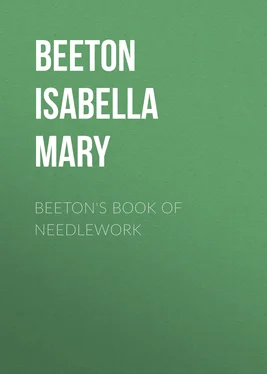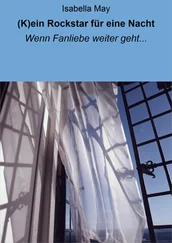Isabella Beeton - Beeton's Book of Needlework
Здесь есть возможность читать онлайн «Isabella Beeton - Beeton's Book of Needlework» — ознакомительный отрывок электронной книги совершенно бесплатно, а после прочтения отрывка купить полную версию. В некоторых случаях можно слушать аудио, скачать через торрент в формате fb2 и присутствует краткое содержание. Издательство: Иностранный паблик, Жанр: foreign_antique, foreign_home, Хобби и ремесла, на английском языке. Описание произведения, (предисловие) а так же отзывы посетителей доступны на портале библиотеки ЛибКат.
- Название:Beeton's Book of Needlework
- Автор:
- Издательство:Иностранный паблик
- Жанр:
- Год:неизвестен
- ISBN:нет данных
- Рейтинг книги:5 / 5. Голосов: 1
-
Избранное:Добавить в избранное
- Отзывы:
-
Ваша оценка:
- 100
- 1
- 2
- 3
- 4
- 5
Beeton's Book of Needlework: краткое содержание, описание и аннотация
Предлагаем к чтению аннотацию, описание, краткое содержание или предисловие (зависит от того, что написал сам автор книги «Beeton's Book of Needlework»). Если вы не нашли необходимую информацию о книге — напишите в комментариях, мы постараемся отыскать её.
Beeton's Book of Needlework — читать онлайн ознакомительный отрывок
Ниже представлен текст книги, разбитый по страницам. Система сохранения места последней прочитанной страницы, позволяет с удобством читать онлайн бесплатно книгу «Beeton's Book of Needlework», без необходимости каждый раз заново искать на чём Вы остановились. Поставьте закладку, и сможете в любой момент перейти на страницу, на которой закончили чтение.
Интервал:
Закладка:
Mrs. Beeton
Beeton's Book of Needlework
SAMUEL BUTLER'S PREFACE
The Art of Needlework dates from the earliest record of the world's history, and has, also, from time immemorial been the support, comfort, or employment of women of every rank and age. Day by day, it increases its votaries, who enlarge and develop its various branches, so that any addition and assistance in teaching or learning Needlework will be welcomed by the Daughters of England, "wise of heart," who work diligently with their hands.
The recent introduction of Point Lace has brought a finer, and, apparently, more difficult class of fancy work into general favour. Ladies may now, however, confidently commence, with our patterns before them, to reproduce Antique laces; for care and patience, with a knowledge of Point Lace stitches, are alone required to perfect the beautiful work, which, as shown in existing specimens of exquisite Old Lace, constitute the chief glory of women's refined industry in past centuries.
INSTRUCTIONSin TATTING, in EMBROIDERY, in CROCHET, in KNITTINGand NETTING, in BERLIN WOOL WORK, in POINT LACE, and GUIPURE D'ARTare prefixed to the pages devoted to these separate branches of needlework. The whole work is interspersed with coloured and other Patterns in Point Lace, Guipure d'Art, Tatting, Embroidery, and Designs for Monograms and Initials for marking handkerchiefs and table-linen. The quantity of materials required for each class of work is also given with every pattern.
The idea of combining a series of minute and exact instructions in fancy needlework with useful patterns was conceived some years ago by one whose life was devoted to the inculcation of the practical duties of woman's life, and to assisting her sex in their daily work of HOUSEHOLD MANAGEMENTand REFINEMENT.
Her great wish was that her BOOK OF NEEDLEWORKshould be as valuable in its way to her Countrywomen as her work upon Household Management was useful in showing the best mode of providing for the diurnal wants of families. Other hands have brought to a conclusion her original plans. The best attainable workers have contributed to this volume. Only those who knew the extent of the late Mrs. Beeton's design, will miss, in the pages now before them, "the touch of a vanished hand."
S.O.B.Paternoster Row, 1870.
TATTING
TATTING INSTRUCTIONS
The needlework called Tatting in England, Frivolité in French, and Frivolitäten in German, is a work which seems, from all accounts, to have been in favour several generations ago. Modern ingenuity has discovered some ways of improving on the original plan of tatting, which was, indeed, rather a primitive sort of business as first practised. To Mrs. Mee, one of our most accomplished artistes in all matters connected with the work-table, belongs, we believe, the introduction of the plan of working from the reel instead of the shuttle. By this alteration the advantage of the shuttle being constantly kept filled with cotton was gained, and the necessity also obviated for frequently joining the thread; and to Mdlle. Riego, equally distinguished in all details appertaining to the employment of the needle, ladies are indebted for an arrangement by which the same thread used in the making of the pattern is used for fastening the work. The old plan only provided for the working of the different portions which constituted the pattern, and then these portions had to be sewn together with a needle and thread. The ingenious workers on the Continent have also given much attention of late to the art of tatting, and our instructions now printed comprise what we consider the best mode of learning and doing this exceedingly interesting and fashionable work.
Tatting differs entirely from crochet, and is composed of stitches forming knots . It is intended as an imitation of point lace, and is especially used for trimming under-linen, on account of its strength.
To make the stitches or knots a small instrument is used, called a shuttle . This shuttle consists of two oval pieces, flat on one side and convex on the other, and is made of wood or ivory.
The two oval pieces are joined together by a strong cross-piece. The illustration shows the construction of the shuttle. These shuttles are made in ivory, pearl, tortoiseshell inlaid with pearl, and silver; they are also manufactured in coloured bone, black, red, and white. The best to work with are the pearl for a white shuttle, and the inlaid tortoiseshell for a black shuttle; the prices vary from sixpence to one shilling and two-and-sixpence each. In selecting a shuttle be careful to see that the ends close, as if dropped it soon becomes unthreaded, which is very inconvenient. The cotton intended for the work is wound round this shuttle, and the thickness of the cotton varies according to the style of work. It is better to use the proper tatting cotton, because it is stronger than the ordinary kinds; this is manufactured by Messrs. Walter Evans and Co. for the purpose. Their Boar's Head Cotton is also frequently used, and answers very well.
Shuttles.
These are made in 3 sizes:–Finest, No. 1; No. 2, useful medium size; No. 3, the largest.
The Way to Hold the Hands.
Take the shuttle in the right hand, between the thumb and second finger, and allow the forefinger to remain at liberty, and rest the under part of the shuttle between the second and third and on the middle finger. Place the thread round the three middle fingers of the left hand, so as to form a loop, keeping the second and third fingers a little apart, and bring the cotton again between the thumb and forefinger, letting the end fall within the palm of the hand, while the end of cotton which holds on to the shuttle passes over the thumb-nail.
To Make a Stitch.
Keep the hands in the position above described; pass the shuttle at the back, through the loop–that is, between the second and third fingers. Take the end of the shuttle which comes out from the loop between the forefinger and thumb of the right hand, and strain the cotton very tightly towards the right. When the cotton is drawn through the loop, this cotton must not be impeded by the fourth finger; it should, on the contrary, slide over it, and be drawn tight. It should divide the loop into two parts. After this withdraw the second left-hand finger, which is above the cotton, and pass it again under that cotton, so as to draw up the loop. A half-stitch is thus formed, and must be tightened by being drawn closely to the forefinger and thumb of the left hand. For the remaining half of the stitch keep the hands in the same position, but, instead of letting the cotton fall over the thumb, pass this cotton over the back of the hand; then let the shuttle fall between the second and third fingers of the left hand, in front, and take it out again at the back, strain the cotton very tightly, withdraw the second finger from the loop, letting the cotton which is behind the hand sweep over the fingers. When this is done, guide with the unoccupied fingers of the left hand this second half-stitch up to the other, thus completing one stitch .
The Way to Make a Loop in Tatting.
When a certain number of stitches are made, very tightly draw in the loop by straining the cotton until the first stitch touches the last, and thus a loop is formed. During this process the stitches should be held tightly between the forefinger and thumb.
The Way to Make a Purl.
A purl is a small loop of cotton often used as an edging in tatting, as, for instance, round the outer edge of the ovals in tatted insertion No.
Читать дальшеИнтервал:
Закладка:
Похожие книги на «Beeton's Book of Needlework»
Представляем Вашему вниманию похожие книги на «Beeton's Book of Needlework» списком для выбора. Мы отобрали схожую по названию и смыслу литературу в надежде предоставить читателям больше вариантов отыскать новые, интересные, ещё непрочитанные произведения.
Обсуждение, отзывы о книге «Beeton's Book of Needlework» и просто собственные мнения читателей. Оставьте ваши комментарии, напишите, что Вы думаете о произведении, его смысле или главных героях. Укажите что конкретно понравилось, а что нет, и почему Вы так считаете.












